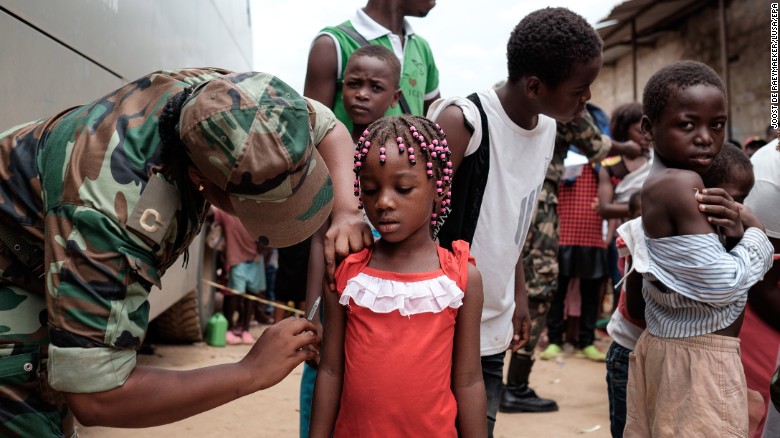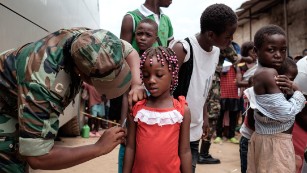By Debra Goldschmidt, CNN
Updated 2306 GMT (0706 HKT) March 25, 2016

Angolan military administers a yellow fever vaccine to a child at 'Quilometro 30' market, Luanda, Angola.
(CNN)More than 1,100 people have been diagnosed with yellow fever in Angola since December, according to the World Health Organization, and at least 178 have died. It's the worst outbreak of yellow fever in the country in three decades, and the supply of vaccines is running low.
The outbreak began in the capital of Luanda but has now spread to at least 10 of the 18 provinces in the country.
"With the majority of cases reported in ... Luanda, the situation is more dangerous and difficult to contain because the disease can spread easily from one person to another. We are already seeing cases spread to a number of provinces outside Luanda," Dr. Sergio Yactayo, WHO expert on epidemic diseases, said in a WHO publication.
Of greater concern to health officials is that China, the Democratic Republic of Congo and Kenya have reported cases they suspect were imported from Angola. Namibia and Zambia, which border Angola, also are on high alert, the WHO said.
"The worry is that this could result in a widespread outbreak of yellow fever in Angola, Asia and other areas," Dr. Tom Frieden, director of the U.S. Centers for Disease Control and Prevention, told CNN.
According to WHO, there are between 84,000 and 170,000 cases of yellow fever a year and as many as 60,000 of those cases are fatal. Yellow fever is a mosquito-borne disease transmitted by two types of mosquitoes. One is Aedes aegypti, the same type of mosquito that transmits Zika virus and dengue fever.
Yellow fever is a viral hemorrhagic illness. It's transmitted to people after a mosquito becomes infected from biting an infected monkey and then the infected mosquito bites a person and infects him or her.
Symptoms usually begin three to six days after a bite from an infected mosquito and last for about three or four days. They include fever, muscle pain, nausea, vomiting and loss of appetite. Yellow fever can be confused as dengue fever, malaria or other illnesses. Fifteen percent of infected individuals experience a second phase of illness within 24 hours of when they first become sick. This can include jaundice and bleeding from the eyes, nose, mouth, stomach and, eventually, bloody vomit and feces.
There is no treatment for yellow fever. Those who are sick are given supportive care, which can include fluids, pain management and monitoring. Fifty percent of patients who experience this second phase of illness die within 10 to 14 days.
There is a vaccine that protects against the virus. Health officials launched a mass vaccination program in February to try to contain this outbreak. Officials in Angola developed a plan to vaccinate nearly 6.5 million people in Luanda and so far 87% of those targeted have been vaccinated. The WHO considers this a success. But supply isn't meeting the demand for the vaccine because big outbreaks of yellow fever are unusual.
"We have to keep going and vaccinate all the people in Luanda and the affected provinces to end this outbreak. This is an enormous job which is exhausting supplies of vaccines," Yactayo said.
The emergency stockpile of the vaccine has been exhausted, the WHO said. Another 1.5 million doses are needed for residents of Luanda alone. In the meantime, shipments designated for the national routine vaccination there are being redirected to help control the outbreak.
"It's possible we could run out of vaccine," Frieden said.
Vaccine manufacturers are doing their part to increase vaccine production but the process takes some time, he said.
Travelers to the country, and any country where yellow fever circulates, including 33 other African countries, are advised to be vaccinated before traveling. Many of those countries require proof of vaccination upon arrival.


No comments:
Post a Comment